Making trout rods with solid glass
This is Kamimura from Hitotoki Works, a manufacturer of trout rods with detachable rods and grips, as well as rod building parts!
Today, I will show you how to make a trout rod using solid glass (solid material).
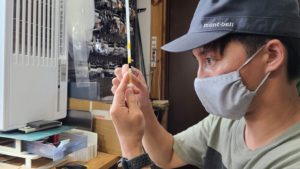
First, we will explain the advantages and disadvantages of glass rods from Hitotoki Works' perspective.
What are the advantages of glass rods?
Affordable and available
Recently, demand for glass materials has increased worldwide in markets other than fishing, causing prices to skyrocket...
Hitotoki Works has developed and begun selling DIY glass solids specifically designed for mountain streams.
The price is only 1,900 yen (excluding tax)!
▼Click
This benefit is huge, as carbon blanks cost over 10,000 yen.
●It's fun because it bends a lot when you hook a fish.

Glass solid is a rod that you can enjoy after hooking the fish.
Because it is so flexible and has no resilience, it bends a lot.
It bends so easily that fighting the fish becomes a lot of fun.
Light lures are easy to throw
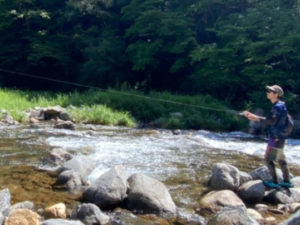
When you swing the rod, it is flexible and has a heavy weight, so it bends just by its own weight.
Therefore, the rod bends regardless of the weight of the lure, making it possible to cast even light lures.
Just as the area rods used in managed fishing areas are extremely soft, even 1g lures can be cast easily.
●Hard to detect
Glass material has the characteristic of low elasticity (weak return to shape), so it is easy to absorb the impact of a fish fight and the fish is less likely to thrash around.
The reason why a hooked fish is less likely to struggle is that fish have a habit of escaping in the opposite direction from the direction they are pulled.
Maybe it's the same for any living thing... (;∀;)
That's why there is a type of reel called a lever brake reel used in rock fishing, which puts zero strain on the fish and allows you to stop it from pulling.
If the rod is stiff, the fish will be more likely to thrash around, and if the rod is soft, the fish will be less likely to thrash around.
Personally, I think the biggest advantage of a glass rod is that it doesn't easily lose fish.
●Not easily broken

Thin, fibrous carbon material is vulnerable to scratches.
Glass is scratch-resistant, and solid glass in particular is so scratch-resistant that even small scratches do not affect its strength.
The solid type has a limit strength, so it is unlikely to break even if you use it roughly.
What are the disadvantages of glass rods?
● Heavy weight
Compared to carbon materials, the weight is heavier.
Because of its heavy weight, repeated casting and lure action when doing mountain stream lure fishing can put a strain on your wrists.
To reduce the strain on your wrist, you can solve the problem to some extent by shortening the overall length .
If it is under 4 feet long, you can fish it with little stress.
●Hooking is difficult
Glass rods even absorb hooking power, so the hooking power does not reach the fish, making it impossible to hook it.
When using a glass rod, we recommend using PE line, which has less stretch!
It's even better if the hook is thin.
You may be concerned about using a thin-shaft hook when catching a large fish, but due to the flexibility of glass, there is less need to worry about the hook stretching!
Poor sensitivity
Absorbing shocks also absorbs vibrations, making it difficult for the vibrations to reach your hand and reducing sensitivity.
It is very difficult to fully sense the movement of the lure and make it take action.
●Lack of distance
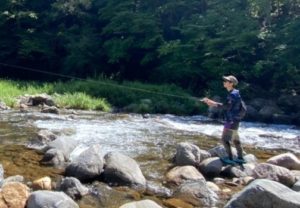
Because there is no repulsive force, you cannot use the rod's restoring force to cast the lure far.
It won't affect you at all if you're in a small river or stream, but if you want to cast far in an open area...
is.
●Poor operability
This is also due to poor recovery ability.
Due to its poor restoring force, it takes time for the bent tip to return to its original shape, making it difficult to give the lure a quick flat action, and in order to get a solid action, you need to twitch it with strong force , otherwise the force will not be transmitted to the lure.
This puts strain on your wrists...
This is also a problem that is solved the more you shorten the rod.
Even if you make it a short rod, there is still a big gap compared to a carbon rod.
How to make a glass rod
This introduction has become quite long, but...
I want you to fully understand the characteristics of glass material before you start working on making rods.
Glass blanks for mountain stream lures

This time, we will introduce how to make glass rods using newly released blanks designed specifically for mountain streams.
The glass blanks we will be using this time are designed to bend firmly when casting, and to allow for firm control with the tension of the butt section when using a lure.
When swinging the blank alone, it may feel a little stiff, but by attaching the all-stainless steel guide set (sold separately), the action changes dramatically.
The blank is 1,000 mm long, but the butt section has a 100 mm straight section with an outer diameter of Φ5.4.
If you want to use it as short as possible, you can cut off 100mm of the straight section without compromising the action.
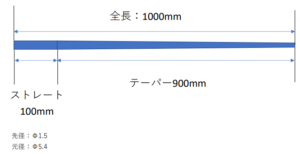
If you attach a ferrule to a blank cut to 900mm and then attach a 235mm grip, you will end up with a rod about 3ft 7in long.If you attach a ferrule to a 1000mm blank without cutting it and then attach a 235mm grip, you will end up with a rod about 4ft long.
Guide installation
Since glass material has its own weight and has no resilience, it is difficult to enjoy the benefits of titanium's light weight, so we will be making a bait rod using an all-stainless steel guide set!
▼Click
The top guide is the same stainless steel PLGST4.5-1.6 .
Remove the spine and glue it with two-component epoxy glue.
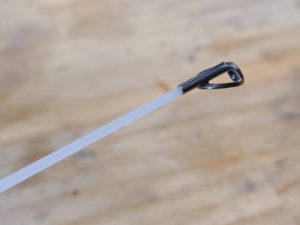
The other guides are also secured with thread.
I wrapped it in black around a purple pin line.
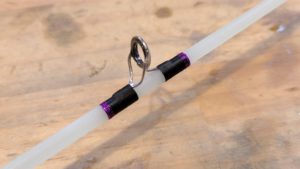
If you cut the guide spacing to 900 mm, please refer to the settings below.
●Bait 900mm setting
TOPG-1G: 70mm
1G-2G: 75mm
2G-3G: 80mm
3G-4G: 90mm
4G-5G: 100mm
6G-7G: 110mm
7G-8G: 130mm
●Spinning 900mm setting
TOPG-1G: 70mm
1G-2G: 75mm
2G-3G: 80mm
3G-4G: 90mm
4G-5G: 95mm
6G-7G: 100mm
7G-8G: 120mm
If you use it at 1000mm, set it as follows.
●Bait 1000mm setting
TOPG-1G: 70mm
1G-2G: 75mm
2G-3G: 80mm
3G-4G: 90mm
4G-5G: 100mm
6G-7G: 120mm
7G-8G: 140mm
●Spinning 1000mm setting
TOPG-1G: 70mm
1G-2G: 75mm
2G-3G: 80mm
3G-4G: 90mm
4G-5G: 100mm
6G-7G: 110mm
7G-8G: 130mm
Since glass material bends quite a bit, the line is set in a spiral so that it does not interfere with the blank when bent!
*Not necessary for spinning.
Apparently, people who use their right hand tend to turn to the right... I don't know the details though (;∀;)
The butt guide is set straight to match the reel line.
The three guides above are positioned so that they bend evenly through 180 degrees.
Each piece is estimated to bend 60 degrees.
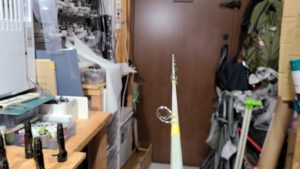
The ferrule goes in 35 mm from the base of the blank, so I added decorative wrapping to the area excluding that part.
However, there is no problem just winding the thread!
It's just a matter of appearance.
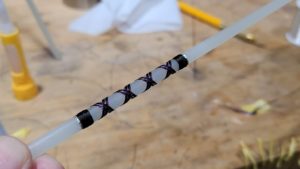
By the way, here is a picture of the decorative wrapping on a glass rod made by a customer.
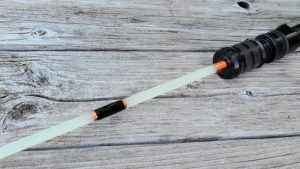
I also put a name sticker on it to make it look like a rod.
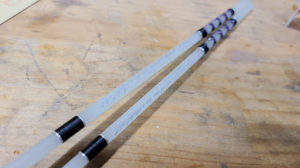
All that's left to do is coat it and glue in a 5.5mm aluminum inner ferrule to finish.
If there is any wobble during the temporary assembly before gluing, apply instant adhesive to the bonding surface of the blanks and wipe it off with paper instead of tissue! By repeating this process, you can form multiple layers of instant adhesive film.
This is a recommended method when there is not enough space to wind thread.
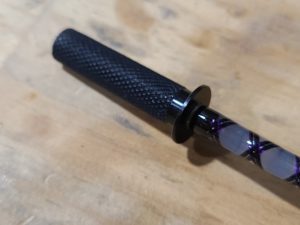
Normally, I would put it on a coated motor and finish it with an epoxy coating, but I don't have the money to buy a coated motor.
If you are in this situation, please consider the coating method introduced in the blog below.
The finish may not be perfect, but it is good enough for actual fishing!! This is a recommended coating method for those who want a good finish.
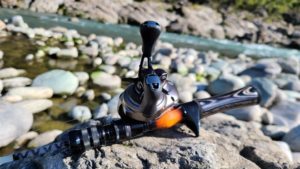
The Grip Joint System makes you feel like a hunter loading his gun and heading out to hunt when you hear the "click" sound when you insert the rod into the grip...
I think it will be (laughs)
For detailed instructions on how to wind and coat the guides and how to attach the ferrules, please refer to the related blog below!!


